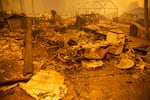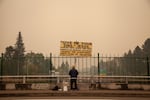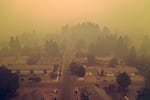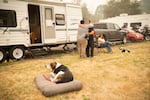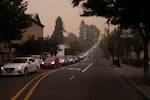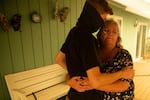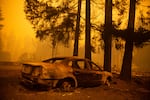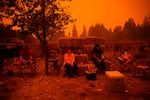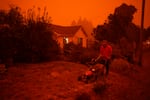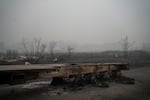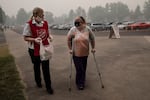Thousands of people across Oregon have been forced to evacuate this week as wildfires burned across hundreds of thousands of acres of land. Often there was little time between the Level 1, or “Get Ready,” notification, and Level 3, or “Go Now.”
That forced many people to make split-second decisions about what to bring, what to leave and where to go.
Making those decisions about what to do in an active evacuation scenario is almost impossibly difficult — even for those of us who cover wildfires and other natural disasters for a living.
This week’s fires are a reminder that very few of us are immune from the risk of wildfire in Oregon, even in a major city.
“If you have trees, brush or even grasslands anywhere around you, you can be at risk,” said Ed Jahn, executive editor for OPB’s science and environment team.
He produced “Unprepared,” an OPB special on earthquake preparedness, and many of those lessons can help us prepare for all kinds of emergency scenarios.
So what can we do ahead of time to get ready? A lot, it turns out.
Get your ‘go kit’ ready
Having a bag packed, ready to go and stashed in a closet is the No. 1 thing you can do to be ready when a sudden evacuation occurs. The best part is that a well-stocked “go bag” will work for any unexpected event, whether it’s a wildfire or an earthquake.
The kit should have enough supplies to last at least three days. You’re going to need clothes, rain gear, water bottles, snacks and other essentials. “Think about what you might need if you’re forced to camp out for a few nights in an emergency shelter or even at a friend’s house that might not have power or water,” Jahn said.
Multnomah County officials recommend that your go kit include:
- Three days of food that doesn’t need to be refrigerated or cooked for each family member
- Three gallons of water per family member
- Battery or hand-crank powered radio (our personal favorite)
- Flashlight
- Extra batteries
- First aid kit
- Supply of medications
- Multipurpose tool
- Copies of personal documents, such as insurance and identification
- Extra cash in small denominations
- Personal hygiene items
- Whistle to signal for help
- Local maps
- Duct tape
- Manual can opener
- Household liquid bleach for water purification, plus eye dropper for measuring
- Waterproof matches
- Baby supplies if needed
- Pet supplies if needed
- Rain gear and warm clothes
- Insect repellent and sunscreen
- Extra clothing
- Emergency blankets
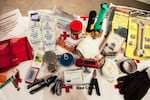
Emergency kits can contain everyday household items, like blankets, non-perishable food and communication devices like radios.
Alan Sylvestre / OPB
Load up your car
In most evacuation scenarios, a car is going to be your ticket out of harm’s way. Jahn said it makes sense to load additional emergency supplies into the nooks and crannies of your vehicle that you might not normally use.
He recommends duplicates of emergency supplies such as gloves, blankets, rain gear and snacks.
“We even keep a small stash of cash in case you need to get out of town and the electricity’s down and you can only pay cash for gasoline,” Jahn said.
The American Red Cross also recommends that you always keep your vehicle filled with three-quarters of a tank of fuel in case you need to leave in an emergency
Rule No. 1 for preparedness: Know thy neighbor
Jahn said the people who are going to be most important in an emergency are going to be the people who live closest to you, on your block. So it’s time to put on your mask, knock on some neighbors' doors and talk it out — with social distance, of course.
“Talk about who has what,” Jahn said. “Who has a chainsaw to clear a road. Who has extra water around, or water tanks even, or medical skills.”
It’s also important to let friends and families know your emergency plan well ahead of time. “If you’re at a Level 1 or 2 evacuation notice, that’s the time to let people know where you’re headed if you do evacuate,” he said.
And don’t expect cellphones to work when the actual crisis does hit, so over-communicating ahead of time is everything.
Trust that people want to help
Jahn admits that even with the best preparations, a true evacuation situation can be an overwhelming, frightening time. But he sees a silver lining in what’s happening across the region right now:
“Oregonians and Washingtonians desire to help each other is really strong,” he said. “People are taking in others' pets, opening their homes to strangers, offering their yards up for horses and livestock.”
So if a crisis does strike, know that you’re not alone. Your neighbors, church and community are there to help. Don’t be afraid to lean on them.
You can find more tips from OPB’s “Unprepared” series here.

